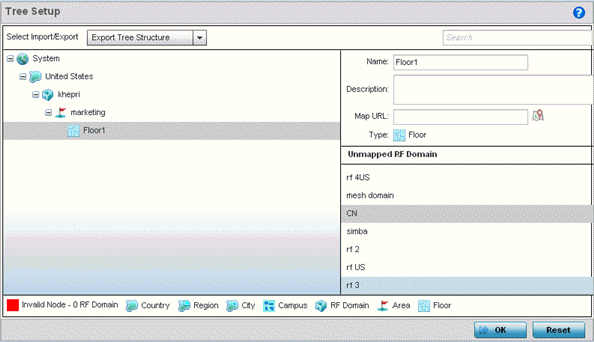Configuring a Hierarchical Tree
About this task
Tree Setup is unique because it is not a policy (which is reused in other objects), but rather a global configuration that represents the tree displayed for Dashboard, Operations, and Statistics. However since it is set as a configuration, it follows the standard configuration methods, and requires a Commit before it taking effect and a Save to become persistent across reboots.
ADSP can run as a virtual machine on NX9500 and NX9510 model service platforms. WiNG communicates with ADSP using a single sign-on (SSO) authentication mechanism. Once the user is logged in, WiNG gains access to ADSP without being prompted to login again at ADSP. There is no synchronization between the WiNG and ADSP databases. ADSP has its own user database stored locally within its virtual machine. This local database is accessed if a user logs directly into ADSP.
WiNG and ADSP must be consistent in the manner events are reported up through a network hierarchy to ensure optimal interoperability and event reporting. To provide such consistency, WiNG has added support for an ADSPlike hierarchal tree. The tree resides within WiNG, and ADSP reads it from WiNG and displays the network hierarchy in its own ADSP interface. The hierarchal tree can also be used to launch ADSP modules (like Spectrum Analyzer) directly from WiNG.

Note
The hierarchical tree is available on both controllers and service platforms, but not access points.- Country
- Region
- City
- Campus
Hierarchy rules are enforced in the containers. For example, a city can be created under a country or region, but not vice versa. An RF Domain can be placed in any container. However, there cannot be any additional containers under the RF Domain. WiNG‘s RF Domain‘s already use areas and floors, and these will continue to work as they currently do. Floors are also numbered to be consistent with ADSP‘s usage.
To configure a hierarchical tree to use with ADSP:




